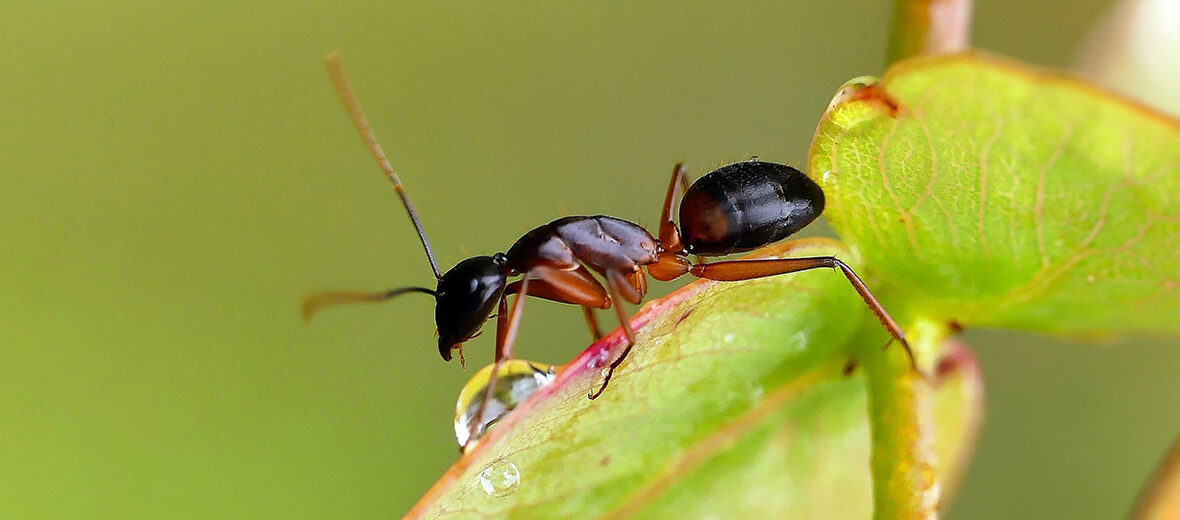
The banded sugar ant, aka sugar ant, is native to southern and eastern Australia. These critters get their name from their love of sugar and sweet foods. The banded common name comes from the orange-brown band that wraps around their gaster (the bulbous posterior portion of the metasoma, aka the posterior part of the body). These ants are abundant and not listed by the IUCN. Enjoy Critter Science’s 1,600th article!! Check back daily for more articles.
First the Stats…
Scientific name: Camponotus consobrinus
Length: Up to .6 inch
Lifespan: Up to 15 years
Now on to the Facts!
1.) These ants were first described in 1842 by German entomologist Wilhelm Ferdinand Erichson.
2.) Banded sugar ants are primarily nocturnal (active at night).
3.) While most frequently found in eucalypt forests, dry sclerophyll woodland (woody plants), grasslands, heaths, and prefer a mesic habitat (a habitat with abundant moisture). They also turn up in urban and suburban areas, where they are considered a pest.
4.) Their diet consists primarily of the sweet liquid produced from aphids and other insects, called honeydew. However, they also prey on insects they come across.
5.) The direct competitor of the banded sugar ants are meat ants.
But wait, there’s more on the banded sugar ant!
6.) They are also preyed on by other ant species, echidnas, and birds. Their eggs are also consumed by native Australians such as Aboriginal individuals.
7.) Colonies consist of 2 types of workers: minor workers and major workers that display different sizes. The 2 castes are easily identified due to the workers being smaller and skinnier, whereas the soldiers are larger and chunkier.
Did you know…?
These ants kill passing insects via a spray or formic acid, aka methanoic acid, from their abdomen. This acid is also corrosive to human skin.
8.) Both the minor and major workers have very strong mandibles that can deliver a slightly painful bite.
9.) They are the most widely distributed ant species in Australia.
10.) Nests are constructed inside holes in wood, plant roots, twigs of shrubs and trees, between rocks, in the soil, and also under paving stones, aka pavers.
But wait, there’s still more on the banded sugar ant!
11.) In order to get other ants to follow the leader, workers engage in carrying other workers, tandem running, or the tried and true leaving a pheromone trail to the source or food for the other ants to follow.
12.) Banded sugar ants will frequently attack the nests of neighboring ant species totally at random, while completely ignoring other nearby ants. They use their mandibles to grip their opponents, and then use formic acid to kill them.
Did you know…?
Meat ants have been observed blocking sugar ant nest holes with small stones and soil to keep them from leaving their nest during the wee hours of the day.
13.) When threatened, an individual sugar ant will lift up its abdomen and use its large mandibles to fend off the perceived threat.
14.) The sugar ants counter nest hole blocking efforts of meat ants by preventing the meat ants from leaving their nest via blocking their nesting holes with debris, a behavior coined as nest-plugging.
15.) Starlings have been documented rubbing banded sugar ants on their feathers and skin, in a behavior known as anting (obtaining chemicals from the ants, that may help with parasite control, make the insects edible, or supplement the bird’s preen oil).
But wait, there’s still a tad more on the banded sugar ant!
16.) Blindsnakes are known to prey on the larvae and eggs of sugar ants.
17.) These ants develop via complete metamorphosis, this means that they pass through a larval and pupal stage before emerging as adults.
18.) While most banded sugar ant colonies are monogynous (a nest that houses just 1 queen), some have been found to be polygynous, where a colony will house multiple queens.
19.) Queens can lay up to thousands of eggs per day, over her lifetime!
20.) These ants, when invading a home, are capable of damaging furniture and fittings due to chewing the wood.
Now a Short Banded Sugar Ant Video!
Be sure to share & comment below! Also, check out the Critter Science YouTube channel. Videos added regularly!
Want to suggest a critter for me to write about? Let me know here.
Some source material acquired from: Wikipedia & IUCN
Photo credit: Ausemade



